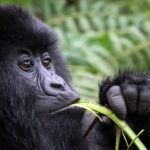More 1000 mountain gorillas are surviving in the whole world, the population is found in Uganda, Rwanda and the Democratic Republic of Congo. Half of the population is in Bwindi Forest National Park in Uganda while the other population in the Volcanoes National Park, Mgahinga National Park and Virunga National Park. Bwindi is the most popular destination visited by tourists who go on safaris in Uganda, a great land gifted by nature! Sitting amidst the mountain gorillas is one of the lifetime experiences that travelers seek for in Uganda.
If you are still wondering about why you should go to Bwindi, here are some fascinating facts that will inspire you to get close to these giants. These great apes are known to exhibit unique characteristics of human beings since the share a close DNA of 98%. However, there is a lot more of the hidden facts you need to know such as;
- All you need to know is that mountain gorillas are listed the largest of the primate’s family ground based and live at high altitudes of about 2200-4300 meters above sea level in a dense thick tropical forest of Bwindi Forest National Park.
- Mountain gorillas live in tropical rain forest, that is why you will not find any mountain gorilla in a zoo. They can only survive in cool temperatures as low as 23 degrees.
- Mountain gorillas are close relatives to human beings sharing DNA percentage of 98%. Their behavior characteristics are similar to humans especially when caring for their young ones. They also have a unique pattern of their finger prints same as humans.
- Mountain gorillas have huge muscles, they have thick black fur, round brown eyes. Mountain gorillas walk on knuckles and sometimes stand if they want to reach something high. Adult males measure 5-9 ft high in an average body weight of 140-200kgs. Adult females measure 4 to 7 ft and 100 kilograms.
- Mountain gorillas live in families, while tracking gorillas in Bwindi forest national park you will be allocated a gorilla family to track. A gorilla family is comprised of adult females, juveniles, infant, black males’ infants and silver back who head the family. A gorilla family usually has about 6- 15 members or more, when a black male grows old grey strip covers its back and that is how it is named a silver back. From there it has a right and position to also head a family.
All the family members care for the young ones carrying and hugging them
- Mountain gorillas are endangered species, they are prone to extinction due to habitant loss, poaching, other human activities like charcoal burning, cultivation and vulnerable to diseases such as pneumonia, tuber culosis, cough, flu, corona virus and other air borne transmittable infections mostly during the wet season.
- Mountain gorillas are shy in nature, but they are aggressive and can charge if a threat is posed to them or their family. They roar in a loud voice as they thumb their chest. In case while tracking in Bwindi forest national park listen to your ranger’s instructions.
- Mountain gorillas are herbivorous in nature. They can feed the whole day between 6:00am to 6 pm, much of their time is spent fore raging in the forest while feeding. They a little bit in the mid-morning around 10 am and resume in the afternoon until late evening as they retire for the night. Mountain gorillas feed on bamboo shoots, vines, berries, thistles, wild celery, singing nestles among others. An adult gorilla can feed up to about 18kgs or more a day. This helps them keep strong as they go about their day. The male gorilla can weigh up to 350 pounds whereas the females weigh about 215pounds.
- Mountain gorillas have a gestation period of 8- 9 months same as human beings. Females became sexually mature at the age of 8-9n years while males are up to 12 and 15 years. Mountain gorillas also have a possibility if giving birth to twins. Gorillas wean their babies at the age of 3 when they can eat and survive on their own.
- Other than un timely death caused by poaching, diseases, mountain gorillas have a life span of 40-50 years. The mortality rate of infant gorillas is less than a year however only 5% for adults.
While tracking gorillas in Bwindi Forest National Park, one can vividly spot some of the striking interesting facts in a gorilla a family, from the one you spend with them.


